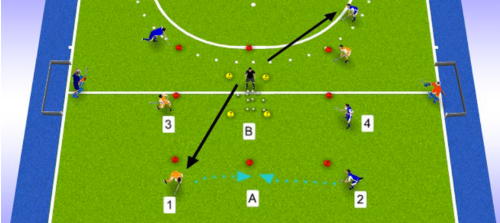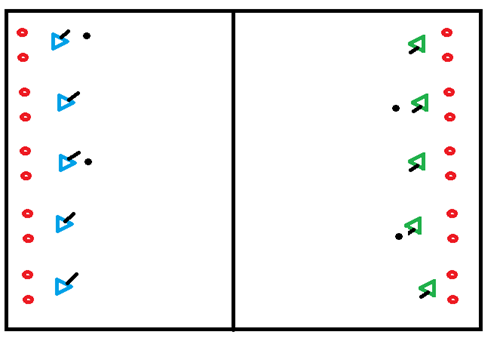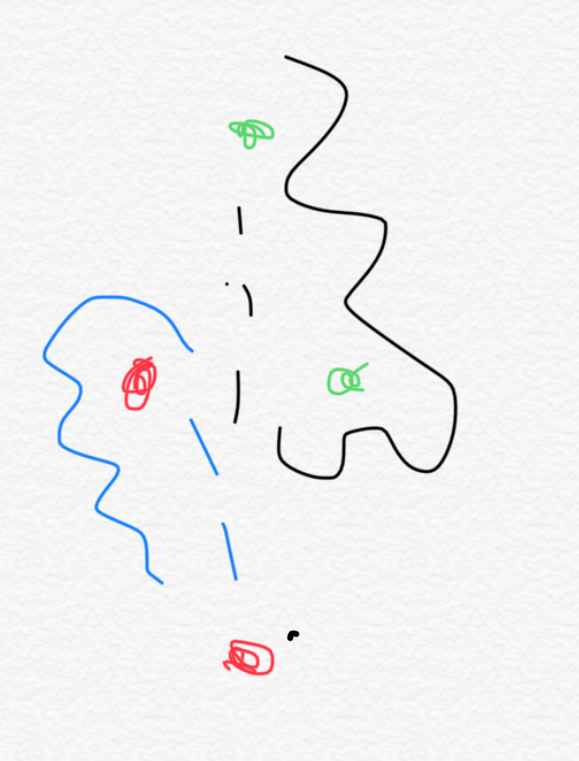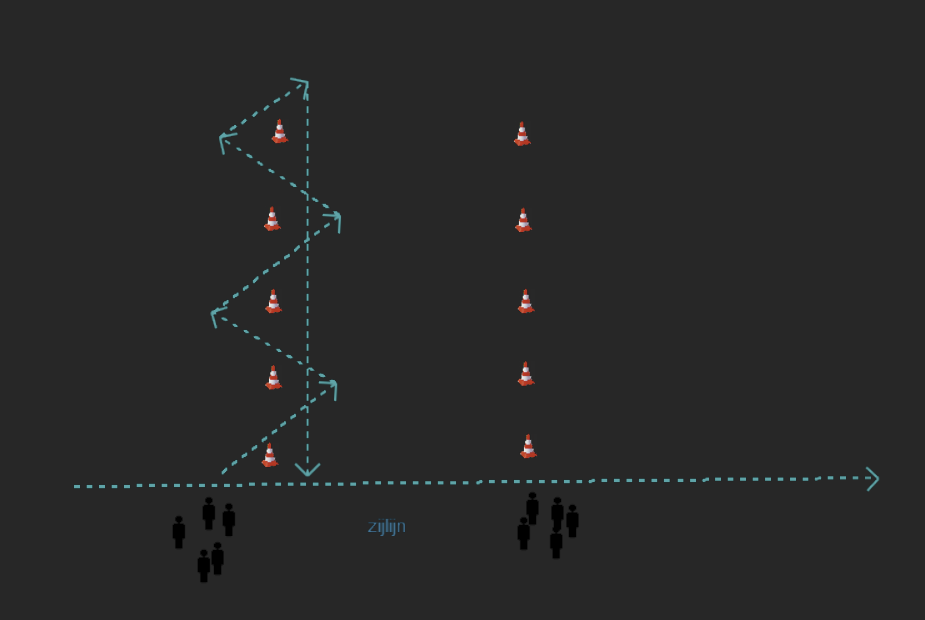Hockey exercises for u11
OrganizationField
: half field
Implementation
General
- Play direction of the game
- Goals in the middle of the field to stimulate awareness of the context of the game (from where do I defend, where do I score?).
- 1:1 : the trainer plays a ball to Orange 1 or Blue 2. Defender's goal is to prevent a goal and score himself.
- 2:1 : The trainer plays a ball to Orange 1 or Blue 2. When Orange 1 gets the ball, Orange 3 can join in the playing field of Orange 1
- Orange 1 and 2 play a 2:1 on Blue 4 (same if Orange 3 gets the ball (Section B)).
- 2:2 : Same as 2:1, but if Blue 2 gets the ball, Blue 4 may join the attack in the section of Orange 1 (Section A).
Tips on ball possession - Perform a feint when passing.
- Cut in after the passing action; protect the ball from the defender.
Tips on non-ball possession
- Find your opponent as quickly as possible.
- Keep your stick on the ball.
- Keep the opponent in front of you (on the forehand).
- ps changeover
At loss of ball:
- Put direct pressure on the ball handler, cut the shortest path to the goal.
On winning the ball:
- Perform a quick action/goal attempt towards goals.
- Making it easier
- Change the start location regularly.
Make it more difficult
- Vary the speed of throw.

- Orange 1 passes to Blue 2.
- Blue 2, 3, 4 try to score in the 2 little goals on the back line.
- Orange 1 tries to get in possession of the ball by defending on its strong side (fh). If he succeeds, he can score in the goal on the middle line (1½ meter wide).
- The exercise is started again when:
- Blue scores in 1 of the 2 goals on the back line at Orange.
- Orange 1 scores in the conversion in the goal of Blue.
- The ball goes over the back line.
Tips Ball possession
- Threaten with the ball and speed towards the goal.
- Look at each other as attackers when offering the ball.
- Help the ball carrier by running away from the ball.
Tips on no ball possession
- Guide with stick on the ground, forehand at ball height.
- Stay out of the ball carrier's physical space.
- Keep the ball on your forehand side. or v2 to create a 1:2 situation (double).
Passing tips
- At loss of possession: Pressure the ball immediately, cut off the shortest path to the goal.
goal.
- When gaining the ball: Keep the ball in quick action/goal attempt towards the goal.
Make it more difficult
- Use 1 goal instead of 2.
- Vary the tackling.
- Players stand with their backs to each other.
- At a distance of 10 m from each player stands a pawn with a ball on it.
- At the whistle or START, the players run to the pawn, both grab the ball, run back to each other and hand each other the ball.
- Then the players run to the pawn with the new ball and place the ball on it.
- Then they both run back to the middle and finish with their backs to each other.
- It is possible to do this in a relay race or several times in a row.
- Two teams with substitutes, substitutions are made when a goal is scored.
- Each person defends a goal, on each field there are 5 goals,
- so there are also 5 people who defend these goals.
- If a goal is scored in your goal, you have to sit on the sidelines and you become a substitute.
- A new player (substitute) from the side enters the field and will defend the goal.
- If a goal is scored, it is 1 point.
- The team that has the most points at the end of the game is the winner.


- Someone runs in from the red, takes the ball in the run and runs away strongly,
- he/she plays it to the other person who is standing near red.
- Green comes running in, takes the ball in the run and turns away strongly, playing to the other person who is standing near green.
- 2 pawns face each other,
- at a random distance (depends on whether you want to push or flatten, for example).
- Player 1 and 3 stand with pawn A.
- Player 2 stands at pawn B.
- 1 plays the ball to player 2,
- 2 receives the ball.
- After player 1 passes the ball, he runs after his ball towards pion B.
- When player 2 has passed again he runs in the direction of pion A.
- etc. etcde
- You can play this exercise with minimum 3 players, maximum 5 otherwise the intensity will be very low.
Overplaying to score
- Two players continuously play the ball over
- until one of them is so close to the goal
- that he can score in the goal.
Variation 2-1 situation:
- Under pressure from the defender, the attackers must now play together and try to score.
- The defender can score a point by conquering the ball and then dribbling over the dead ball line.
- This is the short side without a goal.
- divide the team by 2 and run it.
- Sit on top and blow the whistle on any fouls called
- so they get used to it.

- A slalom exercise
- watch how the hands are holding the stick
- where they have the ball
- And if they use the stick properly when they run through the exercise!
- If it goes well, you can make a game of it and see if they master this. The team that has been through all the exercises first has won.
- Two players stand behind each other. Around them 4 pawns in an angle: 3 next to them/2 behind them
- The ball is passed to the player in front.
- She runs around the pawn in front, turns left and plays the second player between the pawns.
- The second player rebounds between the cones.
- This repeats itself, then the first player finishes on goal.
- Players divided into two groups on one side of the field.
- Two rows of cones next to each other.
- Players pass the ball back and forth while walking past the cones.
- Variations
- Individuals keep ball high along a row of cones, both groups independent of each other.
- Passing the ball two by two
- Individually dribble two balls at the same time, slalom through the cones
- Pass the ball and dribble a second ball at the same time (player says yes).
- Three of you play over 2 balls to the other side.
Goal
- To practise running through the ball in motion (accepting in the run).
Set up
- 2 players stand in a line (e.g. sideline)
- and 1 player stands 10-20 metres away.
- The first player of the team runs a few metres and then passes the ball to the second player.
- and passes the ball to the person standing alone.
- He starts running roughly at the time of the pass.
- This way, he runs through the ball at the moment he takes over.
- The person who passed then moves to the 1-ling position
- The exercise can be made more difficult by lengthening the distance between passes In addition, a passing move can be made before the pass.








